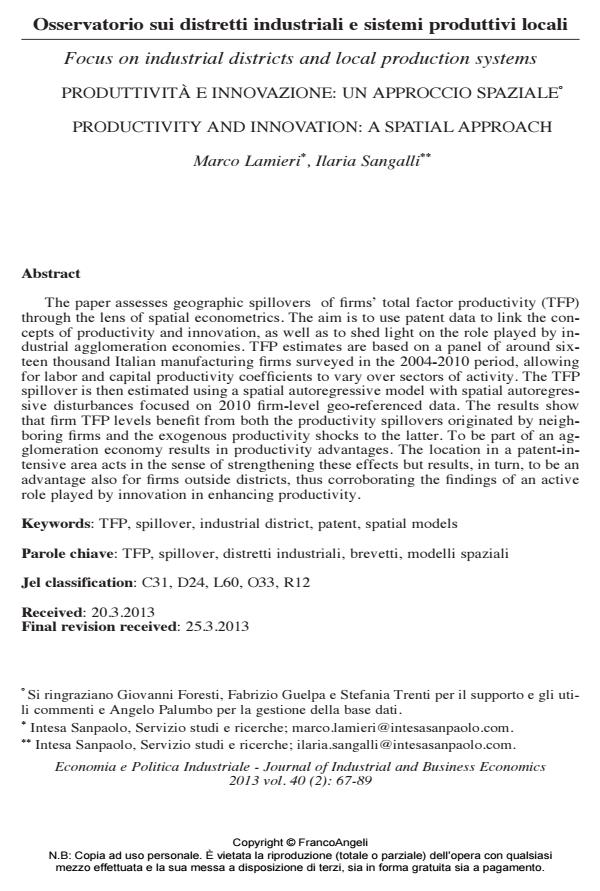Produttività e innovazione: un approccio spaziale
Titolo Rivista ECONOMIA E POLITICA INDUSTRIALE
Autori/Curatori Marco Lamieri, Ilaria Sangalli
Anno di pubblicazione 2013 Fascicolo 2013/2
Lingua Italiano Numero pagine 23 P. 67-89 Dimensione file 255 KB
DOI 10.3280/POLI2013-002004
Il DOI è il codice a barre della proprietà intellettuale: per saperne di più
clicca qui
Qui sotto puoi vedere in anteprima la prima pagina di questo articolo.
Se questo articolo ti interessa, lo puoi acquistare (e scaricare in formato pdf) seguendo le facili indicazioni per acquistare il download credit. Acquista Download Credits per scaricare questo Articolo in formato PDF

FrancoAngeli è membro della Publishers International Linking Association, Inc (PILA)associazione indipendente e non profit per facilitare (attraverso i servizi tecnologici implementati da CrossRef.org) l’accesso degli studiosi ai contenuti digitali nelle pubblicazioni professionali e scientifiche
The paper assesses geographic spillovers of firms’ total factor productivity (TFP) through the lens of spatial econometrics. The aim is to use patent data to link the concepts of productivity and innovation, as well as to shed light on the role played by industrial agglomeration economies. TFP estimates are based on a panel of around sixteen thousand Italian manufacturing firms surveyed in the 2004-2010 period, allowing for labor and capital productivity coefficients to vary over sectors of activity. The TFP spillover is then estimated using a spatial autoregressive model with spatial autoregressive disturbances focused on 2010 firm-level geo-referenced data. The results show that firm TFP levels benefit from both the productivity spillovers originated by neighboring firms and the exogenous productivity shocks to the latter. To be part of an agglomeration economy results in productivity advantages. The location in a patent-intensive area acts in the sense of strengthening these effects but results, in turn, to be an advantage also for firms outside districts, thus corroborating the findings of an active role played by innovation in enhancing productivity.
Parole chiave:TFP, spillover, industrial district, patent, spatial models Parole chiave: TFP, spillover, distretti industriali, brevetti, modelli spaziali
Jel codes:C31, D24, L60, O33, R12
- Competitive advantage and industrial district Enrique Claver-Cortés, Bartolomé Marco-Lajara, Pedro Seva-Larrosa, Lorena Ruiz-Fernández, in Competitiveness Review: An International Business Journal /2019 pp.211
DOI: 10.1108/CR-08-2018-0048 - Firm innovation and spillovers in Italy: Does geographical proximity matter? Paola Cardamone, in Letters in Spatial and Resource Sciences /2018 pp.1
DOI: 10.1007/s12076-017-0193-y - A Spatial Analysis of the R&D-Productivity Nexus at Firm Level Paola Cardamone, in Growth and Change /2017 pp.313
DOI: 10.1111/grow.12169 - Productivity and spatial proximity: evidence from the Italian food industry Paola Cardamone, in International Review of Applied Economics /2020 pp.327
DOI: 10.1080/02692171.2020.1732308 - Spatial agglomeration, innovation and firm survival for Italian manufacturing firms Arnab Bhattacharjee, Ornella Maietta, Fernanda Mazzotta, in Spatial Economic Analysis /2023 pp.318
DOI: 10.1080/17421772.2023.2176538 - Are Italian firms performances influenced by innovation of domestic and foreign firms nearby in space and sectors? Anna M. Ferragina, Giulia Nunziante, in Economia e Politica Industriale /2018 pp.335
DOI: 10.1007/s40812-018-0090-4
Marco Lamieri, Ilaria Sangalli, Produttività e innovazione: un approccio spaziale in "ECONOMIA E POLITICA INDUSTRIALE " 2/2013, pp 67-89, DOI: 10.3280/POLI2013-002004